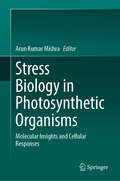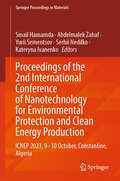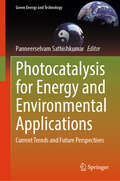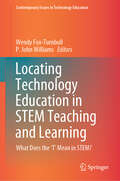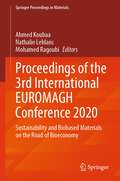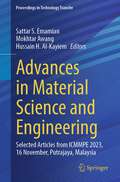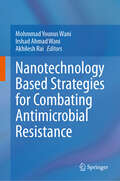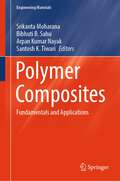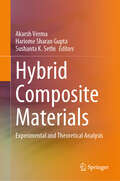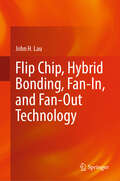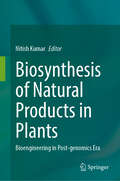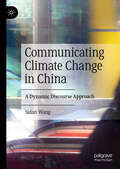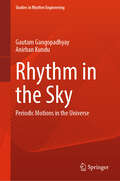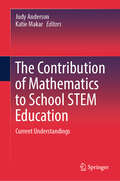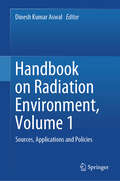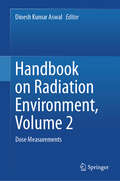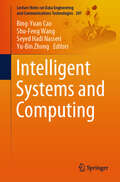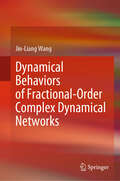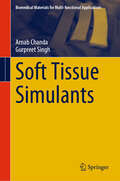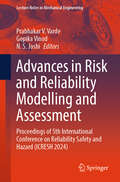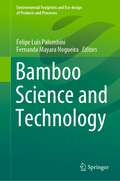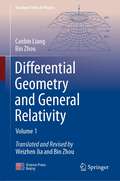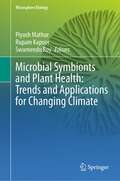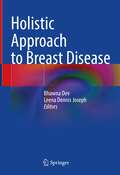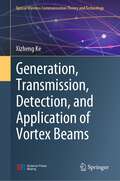- Table View
- List View
Stress Biology in Photosynthetic Organisms: Molecular Insights and Cellular Responses
by Arun Kumar MishraThis book explores the intricate mechanisms underlying the stress responses of phototrophs, which play a critical and foundational role in shaping and sustaining life on Earth.The photoautotrophic entities encounter a spectrum of natural and anthropogenic stresses, inducing a multitude of responses at the physiological, biochemical, genetic, and developmental levels. The comprehension of how these phototrophs adeptly counter stressors transcends mere scientific pursuit; it stands as an essential endeavor for predicting their adaptability in an ever-evolving world and, crucially, for conserving our delicate ecosystems. The book will shed light on the sophisticated interplay of stress signaling pathways and the nuanced engagement of stress-responsive hormones within these life forms. Furthermore, it unveils the cryptic genetic and epigenetic controls dictating stress-related gene expression, yielding profound insights into the enduring recollection of their responses to environmental challenges.This book is an essential read for researchers, educators, and students alike. It offers a comprehensive panorama of stress biology, unveiling the innermost mechanisms at play within photosynthetic organisms discussing their resilience and adaptation.
Proceedings of the 2nd International Conference of Nanotechnology for Environmental Protection and Clean Energy Production: ICNEP 2023, 9–10 October, Constantine, Algeria (Springer Proceedings in Materials #45)
by Smail Hamamda Abdelmalek Zahaf Yurii Sementsov Serhii Nedilko Kateryna IvanenkoThis proceedings book covers the latest research and advancements in nanotechnology for environmental protection and clean energy production. It encompasses a wide range of topics, including physical-chemical nanomaterials science, nanoscale physics, nanocomposites and nanomaterials applications, solids and structures, renewable energy, nanoparticles, and metallic and polymer materials. While focusing on scientific advancements, this book highlights the practical applications of nanotechnology in environmental protection and clean energy production. It bridges the gap between theory and real-world implementation, making it a valuable resource for researchers, students, and professionals seeking practical insights and solutions.
Photocatalysis for Energy and Environmental Applications: Current Trends and Future Perspectives (Green Energy and Technology)
by Panneerselvam SathishkumarThis book presents the existing photocatalytic reactor design and the future developments and the progress needed for both solar light-driven hydrogen generation and environmental purification. The chapters discuss the renewable and commercial aspects of translucent polymer-linked heterojunction nanocomposites as visible light-responsive photocatalysts. Relevant to these areas, the field of growing interest in black-TiO2, perovskites, MXenes and their numerous applications are presented. The framework, structural features and the need of mesocrystals for solar light-driven photocatalysis are also included. The book also discusses the additional features of green chemistry-based synthesis of nanomaterials in order to reduce any secondary pollution that may be released in the environment due to unsafe disposal of solvents. In addition, the importance of bismuth-based nanophotocatalysts towards energy and environmental applications and their future development as alternative photocatalysts for the prevailing nanomaterials are presented. The book also touches upon the idea to generate green fuel hydrogen through photocatalytic and photoelectrochemical techniques. Overall the book highlights contemporary developments in the last decade, the future perspectives of photocatalysis and its application towards energy and environment.
Locating Technology Education in STEM Teaching and Learning: What Does the ‘T’ Mean in STEM? (Contemporary Issues in Technology Education)
by Wendy Fox-Turnbull P. John WilliamsThis book offers clarity and consistency of thinking in relation to Technology Education when situated within a STEM approach to teaching. It examines the range of Innovations and Issues which are being considered by schools as they implement STEM, with particular focus on the place of Technology, or the ‘T’ in STEM. The book is divided into three sections: Philosophy, Implementation and Issues and Innovations, with each containing five to seven chapters. The first section lays the foundations for the remainder of the book: it focuses the readers on the technology aspect of STEM education and situates it to align with the international understanding of technology education. The second section provides insights into how STEM is best implemented to give technology due consideration across a range of disciplines with technology education, including engineering, food technology, and textile technology. This section also provides suggestions for the successful implementation of the STEM approach, and offers further insight through a range of case studies. The third section outlines and discusses a range of issues that pose a threat to the position and understanding of technology within the STEM teaching and learning approach. This section also examines how technology and STEM are situated within, are supported or are threatened by, other current innovations and approaches to teaching an integrated curriculum, such as the Maker Space Movement and Play-based Learning.
Proceedings of the 3rd International EUROMAGH Conference 2020: Sustainability and Biobased Materials on the Road of Bioeconomy (Springer Proceedings in Materials #43)
by Ahmed Koubaa Nathalie Leblanc Mohamed RagoubiThis conference proceeding presents selected manuscripts from the EUROMAGH 2020 Conference entitled “Sustainability and Biobased Materials on the Road of Bioeconomy”. The content highlights technical progress and recent knowledge in the valorization of biomass into biobased materials, from extraction of natural polymers, biopolymers, to biobased mixtures from macro to nano scales. Topics include the following but not limited to: 1. Agroresources, fibers, nanofibers and nanoparticles reinforcements 2. Biocomposites and Nano biocomposites 3. Rheology, Bioprocess and Modeling 4. Plant aggregates, vegetal concrete and Industrial valorisation
Advances in Material Science and Engineering: Selected articles from ICMMPE 2023, 16-Nov, Putrajaya, Malaysia (Proceedings in Technology Transfer)
by Mokhtar Awang Hussain H. Al-Kayiem Sattar S. EmamianThis book presents the latest research advancements in the field of material science, specifically in mechanical, manufacturing, and plant engineering. It includes peer reviewed articles from the 9th International Conference on Mechanical, Manufacturing and Plant Engineering (ICMMPE 2023) held on 16th November 2023 at The Everly Hotel Putrajaya, Malaysia. The conference showcases cutting-edge research and facilitates knowledge exchange among experts in the field of material science, mechanical engineering and their applications.
Nanotechnology Based Strategies for Combating Antimicrobial Resistance
by Mohmmad Younus Wani Irshad Ahmad Wani Akhilesh RaiThis book provides a comprehensive overview of recent advances in nanotechnology as an alternative strategy for addressing antimicrobial resistance (AMR). Examining nanotechnology-based methods such as nanoencapsulation, drug delivery, and conjugation, the text highlights their successful application in treating microbial infections with reduced resistance and off-target toxicity. The introductory section outlines AMR and explores diverse mechanisms of microbial resistance, emphasizing the potential of nanotechnology to surmount these challenges. Subsequent chapters investigate the role of specific nanomaterials—metal nanoparticles, metal oxide nanoparticles, functionalized quantum dots, magnetic nanoparticles, bimetallic nanoparticles, nanocomposites, carbon nanomaterials, and polymer-based nanomaterials—in overcoming antimicrobial resistance. Several chapters focus on the efficacy of nanoemulsions as an antimicrobial delivery method, underscoring their inherent antimicrobial properties, capacity to enhance drug solubility, stability, bioavailability, and targeting potential at the organ and cellular levels. The concluding section provides a detailed review of liposomes, dendrimers-based nanoparticles, and micelles as drug delivery vehicles in the context of combating pathogens resistant to antimicrobials.
Polymer Composites: Fundamentals and Applications (Engineering Materials)
by Santosh K. Tiwari Srikanta Moharana Bibhuti B. Sahu Arpan Kumar NayakThis book highlights the fundamentals and recent advances for developing novel polymer composites for various applications, including 3D printing, automotive, textiles, agriculture, nanogenerators, energy storage and biomedical engineering. It presents various facile processing techniques to prepare polymeric composites with attractive properties like mechanical strength, flexibility, thermal & electrical performances for end used applications from bench to field. This in-sight of properties, performances and utility will lead to technological applications of polymer composites. It provides a platform for evolving and expanding technological solutions for challenges in the contemporary world, and presents a concrete path for advancement in this domain of polymer composite for professionals, researchers, material scientists, and students.
Hybrid Composite Materials: Experimental and Theoretical Analysis
by Akarsh Verma Hariome Sharan Gupta Sushanta K. SethiThe aim of this book is to provide readers with a better understanding of the experimental methods and computational modeling techniques employed in the characterizations of diverse hybrid composite materials. It covers the mechanisms, important aspects, characteristics, formulations, significant elements, and case studies of the hybrid composite materials used in a wide range of applications. To inspire researchers, the most recent studies in the field as well as potential directions for more study are also emphasized.
Flip Chip, Hybrid Bonding, Fan-In, and Fan-Out Technology
by John H. LauThis book focuses on the design, materials, process, fabrication, and reliability of flip chip, hybrid bonding, fan-in, and fan-out technology. Both principles and engineering practice have been addressed, with more weight placed on engineering practice. This is achieved by providing in-depth study on a number of major topics such as wafer bumping, flip chip assembly, underfill and reliability, chip-to-wafer, wafer-to-wafer, Cu-Cu hybrid bonding, WLCSP, 6-side molded WLCSP, FOWLP such as hybrid substrates with PID, ABF, and ultra-large organic interposer, the communications between chiplets and heterogeneous integration packaging, and on-board optics, near-package optics, and co-packaged optics.The book benefits researchers, engineers, and graduate students in the fields of electrical engineering, mechanical engineering, materials sciences, industry engineering, etc.
Biosynthesis of Natural Products in Plants: Bioengineering in Post-genomics Era
by Nitish KumarThis book discusses the importance of plants in terms of their natural bioactive products and medicinal, nutraceutical and health benefits. Plants are natural sources of many pharmaceutical compounds used in traditional and modern medicine, and their mass production and efficient use is imperative in view of the new emerging diseases. This book covers breakthroughs in the research of plant natural products by focusing on how different state-of-the-art biotechnologies facilitate their discovery, the molecular basis of their biosynthesis, as well as synthetic biology. Research on plant's natural products in the pre-genomic era was focused on discovering bioactive molecules with pharmaceutical activities, and identifying individual genes responsible for biosynthesis. In the post-genomics era, however, integration of inter-disciplinary approaches and detailed analysis of all accessible data from multi-informatics is necessary. This would accelerate the full characterization of biosynthetic and regulatory circuit for producing plant natural products.This book is an important reference book for the researchers working in the field of plant natural products and pharmaceutical industries at global level.
Communicating Climate Change in China: A Dynamic Discourse Approach
by Sidan WangThis book explores how China's media narrate climate policy and climate change. With the rapid growth of economy and carbon emissions, China has been seen as having a key role in addressingclimate change and receives substantial attention from the media. In theChinese coverage, climate change issues can be interpreted as various concernsand ideas involving the dimensions of the economy, energy and emissions, publicinvolvement, science and ecology, and responsibility. In this sense, a discourseapproach can be used to understand how the newspapers construct the climatechange discourse and discourse networks in the coverage. This study selectsthree different newspapers in China, namely People’sDaily, China Daily and Southern Weekend. This book will interest scholars of Chinese politics, environmentalists, and media studies scholars.
Rhythm in the Sky: Periodic Motions in the Universe (Studies in Rhythm Engineering)
by Gautam Gangopadhyay Anirban KunduThis book provides a brief and pedagogic introduction to a variety of topics, with a common motif that they all occur, in some way or other, in “the sky”, and involve some sort of “rhythm”. Sky is not just the inside of a dome; there are many strata, each with its own beauties and mysteries. As we go up, the atmosphere thins out and ends, and we move into the space, into the realms of planets, asteroids, and comets, and even further, beyond the solar system into the vast Milky Way galaxy. This is where the night sky comes in, with all its twinkling stars, the stars in our own galaxy. We must use telescopes to explore further. In this book, we will start from the ancient astronomers and how they studied the motion of earth through space. Study of planetary orbits, from Kepler and Newton to Einstein, had been fascinating. We will try to take the reader through the wonderful worlds of the cepheid variables and pulsars to the strange oscillations of the neutrinos and the new eye to look at the universe, namely the gravitational waves. The book stops at the discovery of the black hole at the center of our galaxy, but that is just because we must stop somewhere, or the assortment could go on ad infinitum. Some of these topics are highly mathematical in nature, but we will try to avoid the complicated mathematics as much as possible, without compromising with the rigor.
The Contribution of Mathematics to School STEM Education: Current Understandings
by Katie Makar Judy AndersonThis book presents contemporary STEM education research conducted by mathematics education researchers and their collaborators which highlights the important and pivotal role of mathematics in school STEM education. It showcases evidence of the types of integrated curriculum approaches to STEM education which highlight mathematics as a key component and where mathematical concepts can be learnt through integrated tasks. These examples challenge the idea that mathematics is just an application or ‘servant’ to the other STEM subjects and highlight the contribution that mathematics can make to the understanding and practices of the other STEM subjects. This book fills a void in the current research literature on the role of mathematics in STEM education, provides evidence of the possibilities for designing integrated STEM curriculum and highlights current understandings of the role of mathematics in school STEM education. For researchers, it identifies and elaborates gaps to encourage further exploration in this field.
Handbook on Radiation Environment, Volume 1: Sources, Applications and Policies
by Dinesh Kumar AswalThis handbook provides a comprehensive review of radiation present in the environment, its sources, dose measurement techniques, exposures in natural and man-made radiation environments, policies governing radiation safety, societal applications of radiation technology, radiological and nuclear events, preparedness, response, and mitigation of radiation emergencies. It covers natural and man-made radiation environment with an emphasis on renewed interest in nuclear energy as a clean and green source of power generation. Additionally, it reviews various approaches to understand the fate and behaviour of radionuclides in the terrestrial and aquatic ecosystems. It also presents nuclear technology's diverse applications, from diagnostic and therapeutic nuclear medicine to materials modifications and sustainable waste management strategies and the role of ionizing radiation in ensuring food security and safety. The handbook also highlights the existing (internationally adopted) radiation protection policies, which are originated from linear-no-threshold (LNT) model of dose-response characteristics. The scientific basis of LNT-model and its limitations at low doses prompts a revision of the exiting radiation protection policies for better utilization of the benefits of ionizing radiation. The handbook serves as a comprehensive resource for students, academicians, scientists, engineers, and policymakers interested in seeking an in-depth knowledge of radiation and the multifaceted applications of radiation technology while protecting human health and the environment.
Handbook on Radiation Environment, Volume 2: Dose Measurements
by Dinesh Kumar AswalThe handbook aims to provide a comprehensive resource for understanding ionizing radiation dosimetry, catering to experts, policymakers, and interested readers. The content of the handbook is focused on two main aspects of dose measurements: external dosimetry and internal dosimetry. The section on external dosimetry covers fundamental principles and discusses monitoring techniques across various environments, such as nuclear, industrial, research, and medical facilities. It also covers advanced topics like Bayesian inference and retrospective dosimetry. The internal dosimetry section explores radionuclide biokinetics, simulation techniques, dose evaluation, and monitoring methods. Specific scenarios, such as radon inhalation and off-normal conditions, are addressed, highlighting the importance of precision and intervention. The handbook serves as a comprehensive resource for students, academicians, scientists, engineers, and policymakers interested in seeking an in-depth knowledge of radiation dose measurements and its multi-faceted aspects in protecting human health and the environment.
Intelligent Systems and Computing (Lecture Notes on Data Engineering and Communications Technologies #207)
by Bing-Yuan Cao Shu-Feng Wang Seyed Hadi Nasseri Yu-Bin ZhongThis book includes high quality research papers submitted at the 2022 “Four Session (ICFIE, ICORG, GDORS, CGHMORS) Celebration” Joint International Conference held on December 28, 2022 and the online meeting of the Fuzzy Information and Engineering Branch of the China Operations Research Society on September 17, 2022. It covers topics in the fields of certainty, stochastic uncertainty, and fuzzy uncertainty, including computer science and mathematics, operations research and control, artificial intelligence, information and engineering technology, barrier-free communication for people with disabilities, digital logistics and knowledge representation, medical applications, queuing theory and game theory, algorithms and optimization methods. The book is a valuable reference book for scholars, engineers, management professionals, and graduate, undergraduate, and vocational students interested in computer science, mathematics, and fuzzy mathematics and operations research, as well as their applications in information technology and engineering.
Dynamical Behaviors of Fractional-Order Complex Dynamical Networks
by Jin-Liang WangThis book benefits researchers, engineers, and graduate students in the field of fractional-order complex dynamical networks. Recently, the dynamical behaviors (e.g., passivity, finite-time passivity, synchronization, and finite-time synchronization, etc.) for fractional-order complex networks (FOCNs) have attracted considerable research attention in a wide range of fields, and a variety of valuable results have been reported. In particular, passivity has been extensively used to address the synchronization of FOCNs.
Soft Tissue Simulants (Biomedical Materials for Multi-functional Applications)
by Gurpreet Singh Arnab ChandaSoft tissue simulants, essential for automotive and ballistic testing, medical, and surgical training, have traditionally relied on cadavers and animal tissues. However, their biomechanical properties change with time due to dehydration after death and the biomechanics of the animal models cannot be translated and compared with the human tissues. This book compiles various synthetic tissues used in these applications, addressing their characterization and industry-wide applications. While older simulants lack biofidelity, recent advancements in biofidelic soft tissue simulants offer promising alternatives, yet technology transfer remains limited. This book fills the gap by exploring each simulant's characteristics and current trends, facilitating their adoption in clinical and academic settings. These synthetic tissues have the potential to replace live tissues in surgical training, streamlining biosafety approvals. They also benefit academic researchers by reducing costs and time in biomechanical testing. Anticipated to be the first of its kind, this comprehensive reference book will showcase recent advancements in soft tissue simulant development, serving as a cornerstone text in tissue engineering & biomedical engineering, medical simulation, biomechanics, and related fields.
Advances in Risk and Reliability Modelling and Assessment: Proceedings of 5th International Conference on Reliability Safety and Hazard (ICRESH 2024) (Lecture Notes in Mechanical Engineering)
by Prabhakar V. Varde Gopika Vinod N. S. JoshiThis book presents the proceedings of the 5th International Conference on Reliability Safety & Hazard-2024, held in Mumbai during February 21–24, 2024. It covers the latest advances in artificial intelligence and machine learning in development of risk-conscious culture. Various topics covered in this volume are reliability prediction, precursor event analysis, fuzzy reliability, structural reliability, passive system reliability, digital system reliability, risk-informed approach to decision making, dynamic PSA, uncertainty and sensitivity modeling, among others. The book is a valuable resource for researchers and professionals working in both academia and industry in the areas of complex systems, safety-critical systems, and risk-based engineering.
Bamboo Science and Technology (Environmental Footprints and Eco-design of Products and Processes)
by Felipe Luis Palombini Fernanda Mayara NogueiraBamboo is one of the most sustainable materials in nature due to its fast growth, rapid regeneration, outstanding mechanical properties, and applications in numerous industries. Latest technological advances have been allowing the plant to be studied and applied to exciting new projects. Being bamboo an icon of sustainable development, this book approaches the latest developments in the study of the plant, either as a natural resource or as a source of inspiration for more efficient designs. With the global urging demand for more sustainable practices, innovations in bamboo science and technology are key to the development of environmentally sound solutions.
Differential Geometry and General Relativity: Volume 1 (Graduate Texts in Physics)
by Canbin Liang Bin ZhouThis book, the first in a three-volume set, explains general relativity using the mathematical tool of differential geometry. The book consists of ten chapters, the first five of which introduce differential geometry, which is widely applicable even outside the field of relativity. Chapter 6 analyzes special relativity using geometric language. In turn, the last four chapters introduce readers to the fundamentals of general relativity. Intended for beginners, this volume includes numerous exercises and worked-out example in each chapter to facilitate the learning experience. Chiefly written for graduate-level courses, the book’s content will also benefit upper-level undergraduate students, and can be used as a reference guide for practicing theoretical physicists.
Microbial Symbionts and Plant Health: Trends and Applications for Changing Climate (Rhizosphere Biology)
by Piyush Mathur Rupam Kapoor Swarnendu RoyThis book provides a comprehensive understanding of the complex relationship between microbial symbionts and plants in the era of climate change. It focuses on the plant microbiome associated with different plant organs like roots, leaves, stems, fruit, and seeds, and showcases their significant role in the enhancement of crop yield and protection in a sustainable manner. Concomitantly, acumens to the most emerging trends in plant microbial research that includes rhizosphere engineering and metagenomics are also covered in this title. The association of microbial symbionts with the host offers a wide advantage in terms of acclimatization to varied environmental conditions. A large number of microbes such as cyanobacteria, PGPR, endophytes, and AMF have been shown to improve plant growth and production under the effect of various abiotic and biotic stresses. These microbial symbionts secrete several secondary metabolites, signaling molecules, and hydrolytic enzymes that play a multifarious role in improving plant growth and yield. Moreover, the symbionts have been known to regulate the host responses at the molecular level. Bioprospecting these microbial symbionts will provide an alternative to the chemical-based fertilizers and pave the path for the development of biofertilizers. The book is a suitable reading material for undergraduate and postgraduate students, researchers, and scientists working in the field of agricultural biotechnology, microbiology, mycology and plant pathology, and allied fields of plant and microbial sciences. The book in this context attempts to provide an integrative and exhaustive study as well as research material that would help the scientific community in wide respect.
Holistic Approach to Breast Disease
by Bhawna Dev Leena Dennis JosephThe book covers the entire gamut of breast diseases including all necessary dimensions, such as radiology, pathology, surgery and oncology. It provides a complete spectrum from clinical scenario, imaging investigations and interventions, final histopathological diagnosis and complete treatment plan from medical, surgical and radiation to follow up protocols. It discusses about common and uncommon varied breast diseases encompassing all necessary specialties. It includes stepwise pictorial descriptions of ‘must know’ in breast lesions. It presents high resolution images of the latest technologies in radiology and pathology based on typical case scenarios. The book features special chapters on recent updates and innovative technologies used in imaging, pathology and management of breast diseases. It contains line diagrams and flow charts for quick reading and easy understanding, to be practically implemented as and when required in any concerned specialties.The book is useful for consultants in radiology, pathology, general surgeons, onco-surgeons, super specialists and fellows in breast diseases, and postgraduates in these fields.
Generation, Transmission, Detection, and Application of Vortex Beams (Optical Wireless Communication Theory and Technology)
by Xizheng KeThis book focuses on the key technologies supporting orbital-angular-momentum multiplexing communication: generation, transmission, detection, and application of vortex beams. A series of methods for generating vortex beams are described and compared in detail. Laguerre-Gaussian and Bessel-Gaussian beams are taken as examples to introduce the transport properties of vortex beams in atmospheric turbulence. The authors show that superposition of vortex beam state, interference, diffraction, and grating can realize the detection of the topological charge of vortex beams. The authors also introduce the application of vortex beams in optical communication and the transmission characteristics of partially coherent vortex beams in atmospheric turbulence. Finally, the authors describe vortex beam information exchange and channel reconstruction.
